Create Clickstream Data Analysis Pipeline Using ksqlDB in Confluent Platform
This example shows how you can use ksqlDB to process a stream of click data, aggregate and filter it, and join to information about the users. Visualisation of the results is provided by Grafana, on top of data streamed to Elasticsearch.
These steps will guide you through how to setup your environment and run the clickstream analysis tutorial from a Docker container.
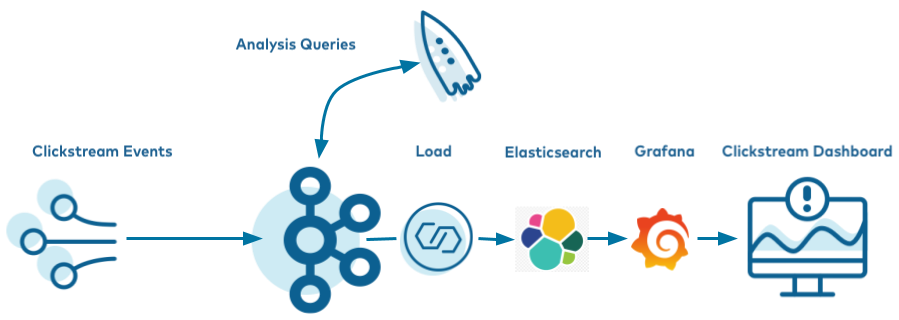
- Prerequisites:
Docker
Docker version 1.11 or later is installed and running.
Docker Compose is installed. Docker Compose is installed by default with Docker for Mac.
Docker memory is allocated minimally at 6 GB. When using Docker Desktop for Mac, the default Docker memory allocation is 2 GB. You can change the default allocation to 6 GB in Docker. Navigate to Preferences > Resources > Advanced.
Internet connectivity
Operating System currently supported by Confluent Platform
Networking and Kafka on Docker
Configure your hosts and ports to allow both internal and external components to the Docker network to communicate.
Configure your hostnames and ports to allow the Docker network’s internal and external components to communicate.
(Optional) curl.
In the steps below, you will download a Docker Compose file. You can download this file any way you like, but the instructions below provide the explicit curl command you can use to download the file.
jq version 1.6 or later
If you are using Linux as your host, for the Elasticsearch container to start successfully you must first run:
sudo sysctl -w vm.max_map_count=262144
Download and run the tutorial
The tutorial is built using Docker Compose. It brings together several Docker images with the required networking and dependencies. The images are quite large and depending on your network connection may take 10-15 minutes to download.
Clone the confluentinc/examples GitHub repository.
git clone https://github.com/confluentinc/examples.git
Navigate to the
examples/clickstreamdirectory and switch to the Confluent Platform release branch:cd examples/clickstream git checkout 8.1.1-post
If you want to manually step through the Clickstream tutorial, which is advised for new users who want to gain familiarity with Confluent Platform, skip ahead to the next section. Alternatively, you can run the full solution end-to-end with this script, which automates all the steps in the tutorial:
./start.sh
You can apply the same concepts explained in this example to Confluent Cloud. Confluent Cloud also has fully managed connectors and ksqlDB applications that you can use, instead of self-managing your own. To try it out, create your own Confluent Cloud instance (see the ccloud-stack utility for Confluent Cloud for an easy way to spin up a new environment), deploy the
kafka-connect-datagenconnectors, submit your ksqlDB queries, and then point your Elasticsearch connector to Confluent Cloud.
Startup
Get the Jar files for
kafka-connect-datagen(source connector) andkafka-connect-elasticsearch(sink connector).docker run -v $PWD/confluent-hub-components:/share/confluent-hub-components confluentinc/ksqldb-server:0.8.0 confluent-hub install --no-prompt confluentinc/kafka-connect-datagen:0.4.0 docker run -v $PWD/confluent-hub-components:/share/confluent-hub-components confluentinc/ksqldb-server:0.8.0 confluent-hub install --no-prompt confluentinc/kafka-connect-elasticsearch:10.0.2
Launch the tutorial in Docker.
docker-compose up -d
After a minute or so, run the
docker-compose psstatus command to ensure that everything has started correctly:docker-compose psYour output should resemble:
Name Command State Ports --------------------------------------------------------------------------------------------------------- control-center /etc/confluent/docker/run Up 0.0.0.0:9021->9021/tcp elasticsearch /usr/local/bin/docker-entr ... Up 0.0.0.0:9200->9200/tcp, 9300/tcp grafana /run.sh Up 0.0.0.0:3000->3000/tcp kafka /etc/confluent/docker/run Up 9092/tcp ksqldb-cli /bin/sh Up ksqldb-server bash -c # Manually install ... Up 0.0.0.0:8083->8083/tcp, 0.0.0.0:8088->8088/tcp schema-registry /etc/confluent/docker/run Up 8081/tcp tools /bin/bash Up
Create the Clickstream Data
Once you’ve confirmed all the Docker containers are running, create the source connectors that generate mock data. This demo leverages the embedded Connect worker in ksqlDB.
Launch the ksqlDB CLI:
docker-compose exec ksqldb-cli ksql http://ksqldb-server:8088
Ensure the ksqlDB server is ready to receive requests by running the following until it succeeds:
show topics;
The output should look similar to:
Kafka Topic | Partitions | Partition Replicas ----------------------------------------------- -----------------------------------------------
Run the script create-connectors.sql that executes the ksqlDB statements to create three source connectors for generating mock data.
RUN SCRIPT '/scripts/create-connectors.sql';
The output should look similar to:
CREATE SOURCE CONNECTOR datagen_clickstream_codes WITH ( 'connector.class' = 'io.confluent.kafka.connect.datagen.DatagenConnector', 'kafka.topic' = 'clickstream_codes', 'quickstart' = 'clickstream_codes', 'maxInterval' = '20', 'iterations' = '100', 'format' = 'json', 'key.converter' = 'org.apache.kafka.connect.converters.IntegerConverter'); Message --------------------------------------------- Created connector DATAGEN_CLICKSTREAM_CODES --------------------------------------------- [...]
Now the
clickstreamgenerator is running, simulating the stream of clicks. Sample the messages in theclickstreamtopic:print clickstream limit 3;
Your output should resemble:
Key format: HOPPING(JSON) or TUMBLING(JSON) or HOPPING(KAFKA_STRING) or TUMBLING(KAFKA_STRING) or KAFKA_STRING Value format: JSON or KAFKA_STRING rowtime: 2020/06/11 10:38:42.449 Z, key: 222.90.225.227, value: {"ip":"222.90.225.227","userid":12,"remote_user":"-","time":"1","_time":1,"request":"GET /images/logo-small.png HTTP/1.1","status":"302","bytes":"1289","referrer":"-","agent":"Mozilla/5.0 (Windows NT 10.0; Win64; x64) AppleWebKit/537.36 (KHTML, like Gecko) Chrome/59.0.3071.115 Safari/537.36"} rowtime: 2020/06/11 10:38:42.528 Z, key: 111.245.174.248, value: {"ip":"111.245.174.248","userid":30,"remote_user":"-","time":"11","_time":11,"request":"GET /site/login.html HTTP/1.1","status":"302","bytes":"14096","referrer":"-","agent":"Mozilla/5.0 (Windows NT 10.0; Win64; x64) AppleWebKit/537.36 (KHTML, like Gecko) Chrome/59.0.3071.115 Safari/537.36"} rowtime: 2020/06/11 10:38:42.705 Z, key: 122.152.45.245, value: {"ip":"122.152.45.245","userid":11,"remote_user":"-","time":"21","_time":21,"request":"GET /images/logo-small.png HTTP/1.1","status":"407","bytes":"4196","referrer":"-","agent":"Mozilla/5.0 (Windows NT 10.0; Win64; x64) AppleWebKit/537.36 (KHTML, like Gecko) Chrome/59.0.3071.115 Safari/537.36"} Topic printing ceased
The second data generator running is for the HTTP status codes. Sample the messages in the
clickstream_codestopic:print clickstream_codes limit 3;
Your output should resemble:
Key format: KAFKA_INT Value format: JSON or KAFKA_STRING rowtime: 2020/06/11 10:38:40.222 Z, key: 200, value: {"code":200,"definition":"Successful"} rowtime: 2020/06/11 10:38:40.688 Z, key: 404, value: {"code":404,"definition":"Page not found"} rowtime: 2020/06/11 10:38:41.006 Z, key: 200, value: {"code":200,"definition":"Successful"} Topic printing ceased
The third data generator is for the user information. Sample the messages in the
clickstream_userstopic:print clickstream_users limit 3;
Your output should resemble:
Key format: KAFKA_INT Value format: JSON or KAFKA_STRING rowtime: 2020/06/11 10:38:40.815 Z, key: 1, value: {"user_id":1,"username":"Roberto_123","registered_at":1410180399070,"first_name":"Greta","last_name":"Garrity","city":"San Francisco","level":"Platinum"} rowtime: 2020/06/11 10:38:41.001 Z, key: 2, value: {"user_id":2,"username":"akatz1022","registered_at":1410356353826,"first_name":"Ferd","last_name":"Pask","city":"London","level":"Gold"} rowtime: 2020/06/11 10:38:41.214 Z, key: 3, value: {"user_id":3,"username":"akatz1022","registered_at":1483293331831,"first_name":"Oriana","last_name":"Romagosa","city":"London","level":"Platinum"} Topic printing ceased
Go to Confluent Control Center UI at http://localhost:9021 and view the three kafka-connect-datagen source connectors created with the ksqlDB CLI.
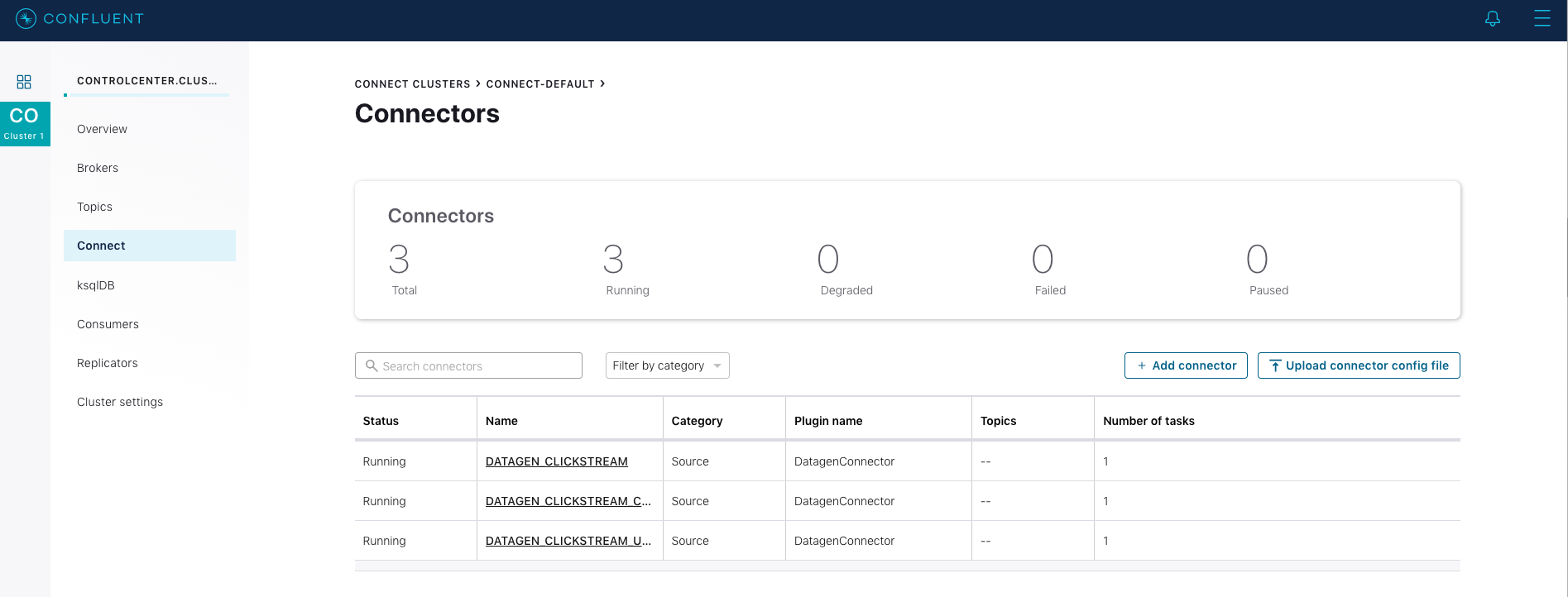
Load the Streaming Data to ksqlDB
Load the statements.sql file that runs the tutorial app.
Important: Before running this step, you must have already run ksql-datagen utility to create the clickstream data, status codes, and set of users.
RUN SCRIPT '/scripts/statements.sql';
The output will show either a blank message, or
Executing statement, similar to this:CREATE STREAM clickstream ( _time bigint, time varchar, ip varchar, request varchar, status int, userid int, bytes bigint, agent varchar ) with ( kafka_topic = 'clickstream', value_format = 'json' ); Message ---------------- Stream created ---------------- [...]After the
RUN SCRIPTcommand completes, exit out of theksqldb-cliwith aCTRL+Dcommand
Verify the data
Go to Confluent Control Center UI at http://localhost:9021, and view the ksqlDB view
Flow.
Verify that data is being streamed through various tables and streams. Query one of the streams
CLICKSTREAM: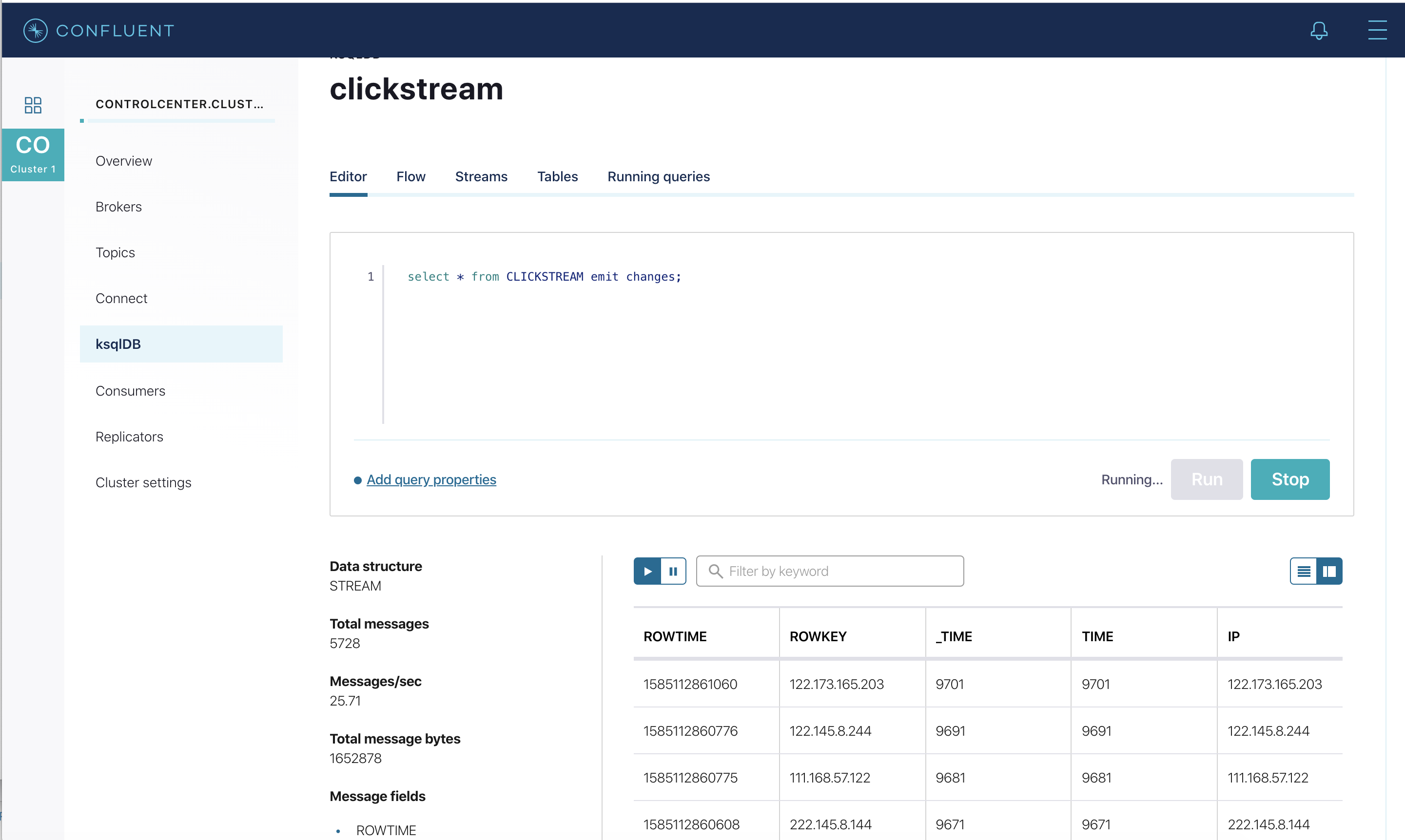
Load the Clickstream Data in Grafana
Send the ksqlDB tables to Elasticsearch and Grafana.
Set up the required Elasticsearch document mapping template
docker-compose exec elasticsearch bash -c '/scripts/elastic-dynamic-template.sh'
Run this command to send the ksqlDB tables to Elasticsearch and Grafana:
docker-compose exec ksqldb-server bash -c '/scripts/ksql-tables-to-grafana.sh'
Your output should resemble:
Loading Clickstream-Demo TABLES to Confluent-Connect => Elastic => Grafana datasource ================================================================== Charting CLICK_USER_SESSIONS -> Remove any existing Elastic search config -> Remove any existing Connect config -> Remove any existing Grafana config -> Connecting KSQL->Elastic->Grafana click_user_sessions -> Connecting: click_user_sessions -> Adding Kafka Connect Elastic Source es_sink_CLICK_USER_SESSIONS -> Adding Grafana Source [...]Load the dashboard into Grafana.
docker-compose exec grafana bash -c '/scripts/clickstream-analysis-dashboard.sh'
Your output should resemble:
Loading Grafana ClickStream Dashboard
Navigate to the Grafana dashboard at http://localhost:3000. Enter the username and password as
useranduser. Then navigate to theClickstream Analysis Dashboard.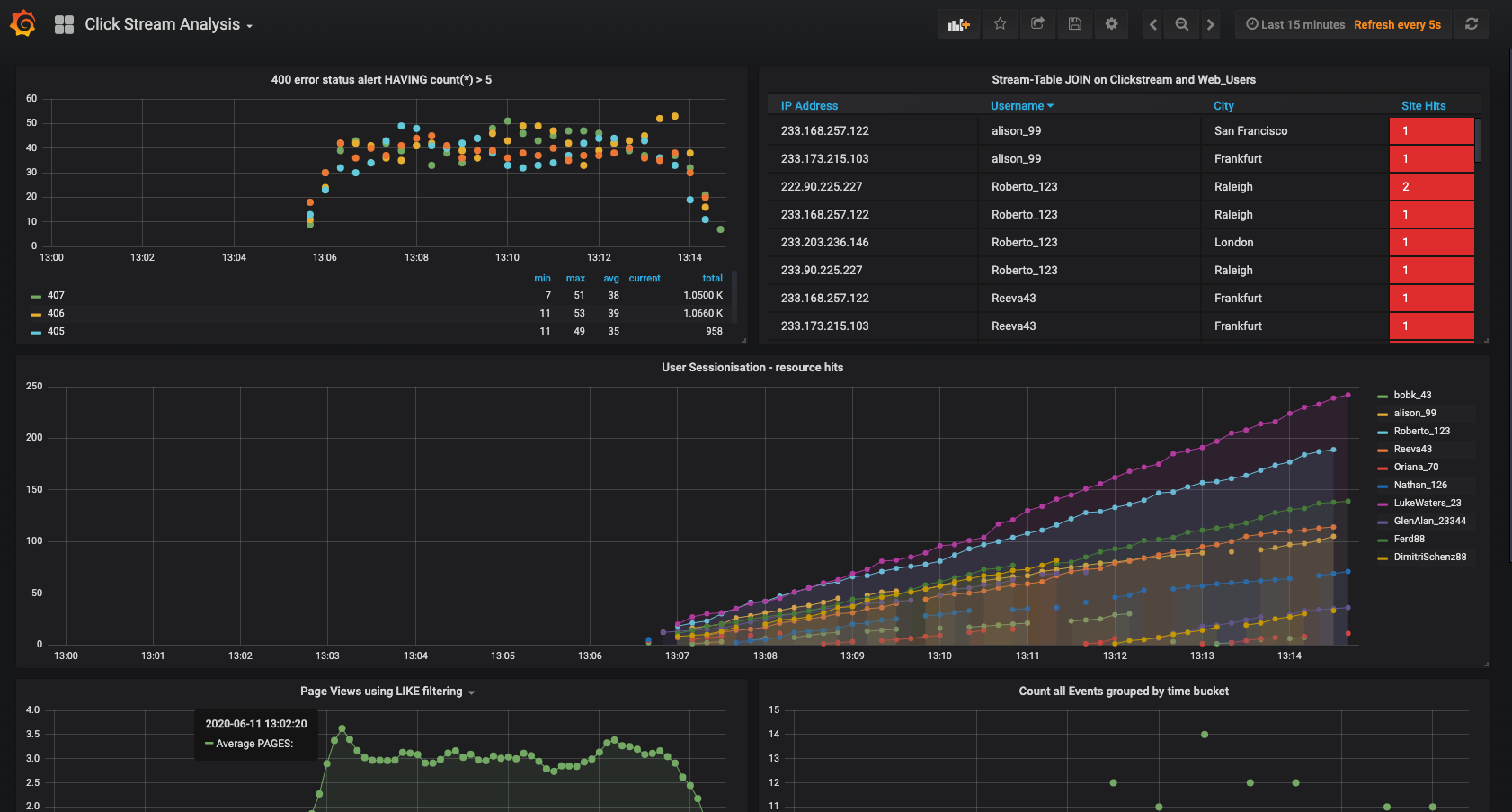
In the Confluent Control Center UI at http://localhost:9021, again view the running connectors. The three kafka-connect-datagen source connectors were created with the ksqlDB CLI, and the seven Elasticsearch sink connectors were created with the ksqlDB REST API.
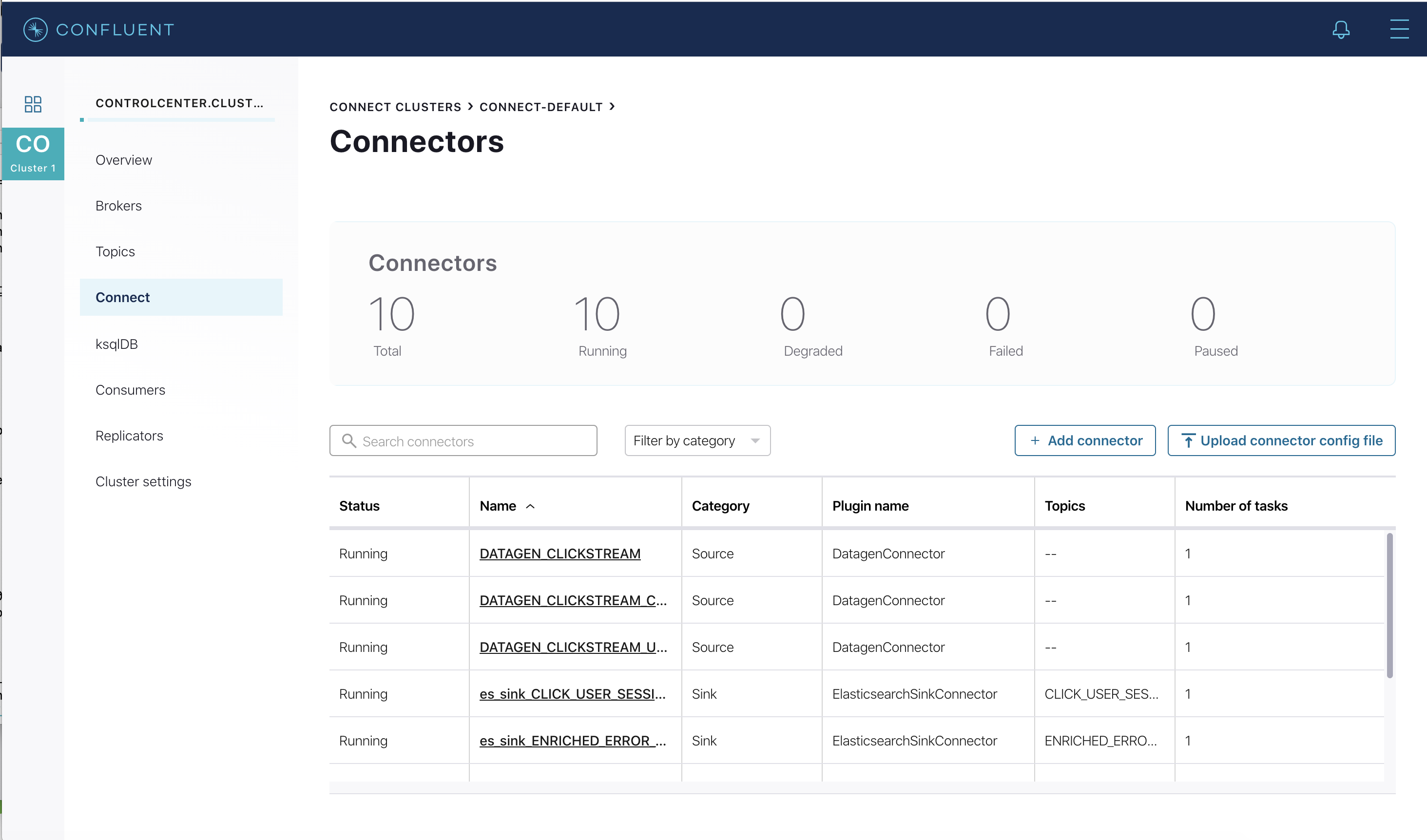
Sessionize the data
One of the tables created by the demo, CLICK_USER_SESSIONS, shows a count of user activity for a given user session. All clicks from the user count towards the total user activity for the current session. If a user is inactive for 30 seconds, then any subsequent click activity is counted towards a new session.
The clickstream demo simulates user sessions with a script. The script pauses the DATAGEN_CLICKSTREAM connector every 90 seconds for a 35 second period of inactivity. By stopping the DATAGEN_CLICKSTREAM connector for some time greater than 30 seconds, you will see distinct user sessions.
You’ll probably use a longer inactivity gap for session windows in practice. But the demo uses 30 seconds so you can see the sessions in action in a reasonable amount of time.
Session windows are different because they monitor user behavior and other window implementations consider only time.
To generate the session data execute the following statement from the examples/clickstream directory:
./sessionize-data.sh
The script will issue some statements to the console about where it is in the process.
View the data in Grafana
Navigate to the Grafana dashboard at http://localhost:3000. Enter the username and password as
useranduser. Then navigate to theClickstream Analysis Dashboard.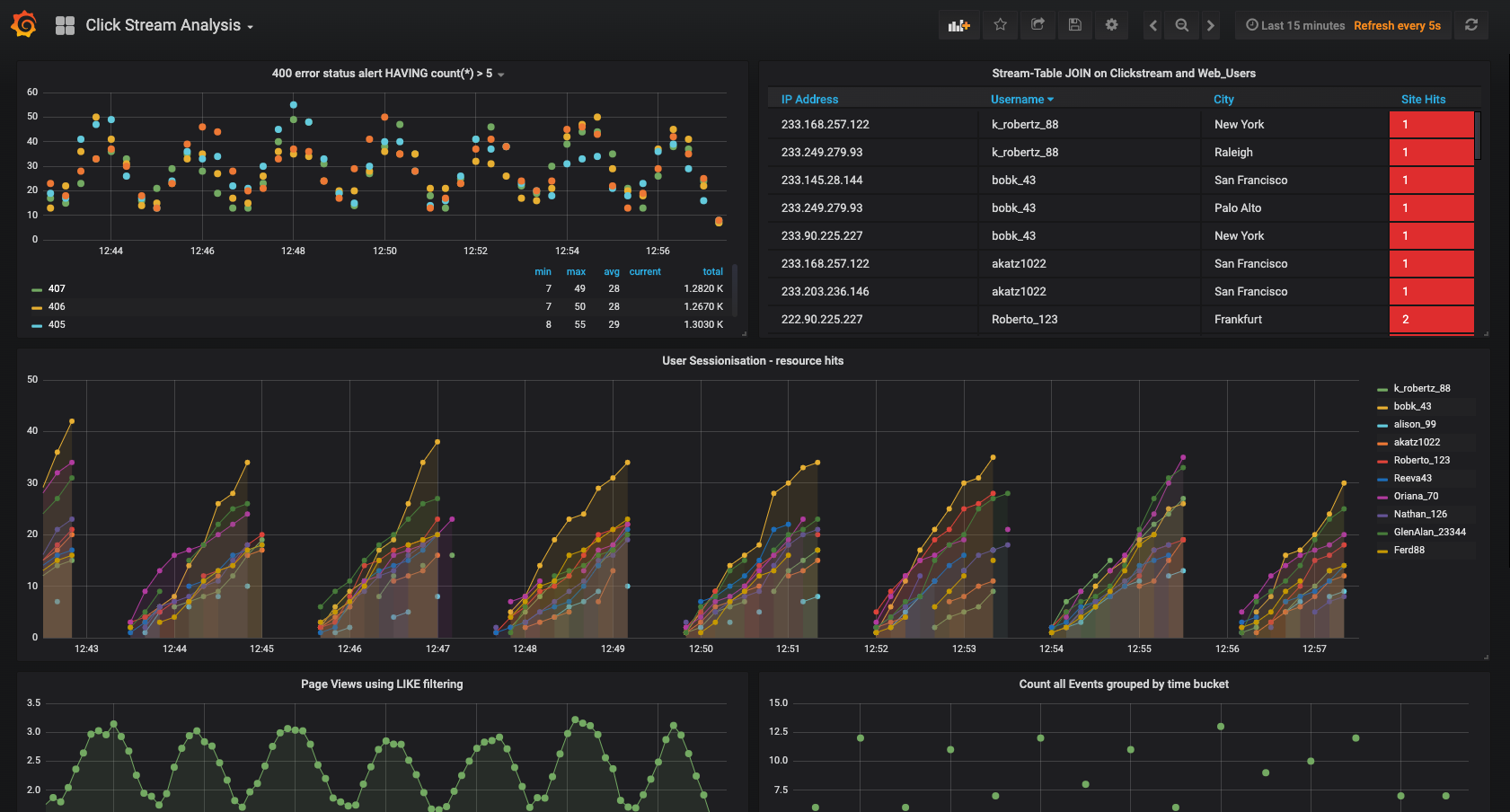
This dashboard demonstrates a series of streaming functionality where the title of each panel describes the type of stream processing required to generate the data. For example, the large chart in the middle is showing web-resource requests on a per-username basis using a Session window - where a sessions expire after 300 seconds of inactivity. Editing the panel allows you to view the datasource - which is named after the streams and tables captured in the statements.sql file.
Troubleshooting
Check the Data Sources page in Grafana.
If your data source is shown, select it and scroll to the bottom and click the Save & Test button. This will indicate whether your data source is valid.